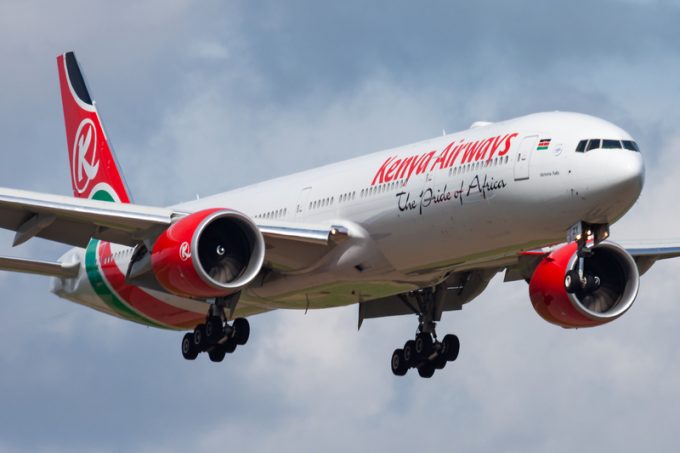In-Depth SWOT Analysis Of Kenya Airways
Kenya Airways is the flagship carrier of Kenya and is the Economic Bluechip company. The airline operates in a highly competitive industry and faces both internal and external factors that affect its operations.
A SWOT analysis is a strategic tool used to identify the Strengths, Weaknesses, Opportunities, and Threats of a company.
Here’s an overview of Kenya Airways in a table:
| ATTRIBUTE | DESCRIPTION |
| Company Name | Kenya Airways PLC |
| Legal Structure | Public Limited Company |
| Ownership | Government of Kenya (48.9%), Private investors (51.1%) |
| Operations | National carrier of Kenya |
| Headquartered | Nairobi, Kenya |
| Founded | 1977 |
| Hub | Jomo Kenyatta International Airport, Nairobi |
| Destinations | 41 destinations across Africa, Europe, Middle East, and Asia (as of 2022) |
| Fleet | 42 aircraft (as of 2023) |
| Employees | Approximately 4,000 (as of 2022) |
| Alliance Membership | SkyTeam |
| Revenue | USD 596 million (2021/22 Financial Year) |
| Net Loss | USD 94 million (2021/22 Financial Year) |
| Challenges | High operating costs, debt burden, overcapacity, competition |
| Opportunities | African market growth, cargo operations, partnerships, ancillary revenue |
| Key Products/Services | Passenger and cargo transportation, codeshare agreements, frequent flyer program |
This table provides an overview of Kenya Airways’ corporate structure, operations, financial performance, fleet, network, and key challenges and opportunities faced by the airline.
KENYA AIRWAYS SWOT ANALYSIS
Kenya Airways, the national carrier of Kenya, has been a key player in the African aviation industry for decades.
As the region’s economic landscape evolves and competition intensifies, it is crucial to assess the airline’s strengths, weaknesses, opportunities, and threats to chart a course for sustainable growth and profitability.
This in-depth SWOT analysis will provide a comprehensive understanding of Kenya Airways’ position in the market and the challenges it faces as it navigates turbulent skies.

Strengths of Kenya Airways:
- Strong Brand Recognition: Kenya Airways enjoys a well-established and respected brand within Africa and beyond. Its reputation for safety, service, and reliability has been built over years of operations, making it a preferred choice for many travelers.
- Strategic Hub Location: The airline’s hub at Jomo Kenyatta International Airport in Nairobi serves as a strategic gateway to Africa, connecting the continent with Europe, the Middle East, and Asia. This advantageous location positions Kenya Airways as a vital link in international air travel networks.
- Membership in Strategic Alliances: As a member of the SkyTeam alliance, Kenya Airways benefits from codeshare agreements, shared loyalty programs, and increased global connectivity, enhancing its reach and appeal to international travelers.
- Modern and Efficient Fleet: With a relatively young fleet comprising Boeing and Embraer aircraft, Kenya Airways enjoys lower operating costs and higher fuel efficiency compared to airlines with older aircraft.
- Skilled and Experienced Workforce: The airline boasts a highly trained and experienced workforce, including pilots, cabin crew, and technical staff, contributing to operational excellence and customer satisfaction.
Weaknesses of Kenya Airways:
- High Operating Costs: Like many airlines, Kenya Airways faces significant operating costs, including fuel expenses, labor costs, and maintenance expenditures, which can strain profitability, especially during periods of economic downturn or fuel price volatility.
- Limited Domestic Market: With a relatively small domestic market in Kenya, the airline’s growth potential is somewhat limited, necessitating a strong focus on regional and international routes.
- Debt Burden: Kenya Airways has been grappling with a substantial debt load, which has hampered its ability to invest in fleet renewal, route expansion, and other growth initiatives.
- Overcapacity and Competition: The African aviation market has experienced overcapacity and intense competition from regional and international carriers, putting pressure on yields and profitability for Kenya Airways.
- Dependence on Tourism: As a significant portion of Kenya Airways’ revenue is derived from tourism, the airline’s performance is closely tied to the fluctuations in the tourism industry, which can be affected by factors such as global economic conditions, security concerns, and health crises.
Opportunities of Kenya Airways:
- Expanding African Markets: With rising disposable incomes, urbanization, and economic growth across Africa, there is a growing demand for air travel, presenting opportunities for route expansion and increased passenger traffic for Kenya Airways.
- Cargo Operations: The airline can capitalize on the increasing demand for air cargo services by enhancing its freight operations, leveraging Kenya’s position as a regional trade and logistics hub.
- Strategic Partnerships and Codeshare Agreements: Forging new partnerships and codeshare agreements with other airlines can help Kenya Airways access new markets, enhance its network, and increase revenue streams.
- Ancillary Revenue Streams: The airline can explore additional revenue sources, such as in-flight services, loyalty programs, and partnerships with hospitality and retail industries, to diversify its income streams.
- Fleet Modernization and Sustainable Operations: Investing in newer, more fuel-efficient aircraft and adopting sustainable practices can reduce operating costs, enhance environmental credentials, and improve customer experience.
Threats of Kenya Airways:
- Geopolitical Instability and Security Concerns: Regional conflicts, political unrest, and security threats can significantly impact air travel demand and disrupt operations, posing a risk to Kenya Airways’ operations and profitability.
- Fuel Price Volatility: As a major operating expense, fluctuations in fuel prices can greatly influence the airline’s profitability, making it vulnerable to external market forces beyond its control.
- Economic Downturns and Currency Fluctuations: Global or regional economic downturns can dampen travel demand, while currency fluctuations can impact the airline’s revenue and costs, given its international operations.
- Increasing Competition: The entry of new low-cost carriers, as well as the expansion of existing regional and international airlines in the African market, could intensify competition and put pressure on Kenya Airways’ market share and profitability.
- Regulatory and Infrastructure Challenges: Outdated or inadequate airport infrastructure, airspace congestion, and changing regulations in various countries can hinder the airline’s operations and efficiency.
As this in-depth SWOT analysis demonstrates, Kenya Airways possesses notable strengths, such as its strong brand, strategic hub location, and membership in global alliances. However, it also faces significant weaknesses, including high operating costs, a debt burden, and overcapacity challenges.
The opportunities lie in tapping into expanding African markets, exploring new revenue streams, and embracing sustainable practices.
Conversely, the threats stem from geopolitical instability, fuel price volatility, economic downturns, intensifying competition, and infrastructure limitations.
To soar high in the increasingly competitive aviation landscape, Kenya Airways must leverage its strengths, address its weaknesses, seize emerging opportunities, and mitigate potential threats through strategic decision-making, operational efficiency, and adaptability.
By doing so, the airline can secure its position as a leading carrier in Africa and continue to provide vital air connectivity across the continent and beyond.





